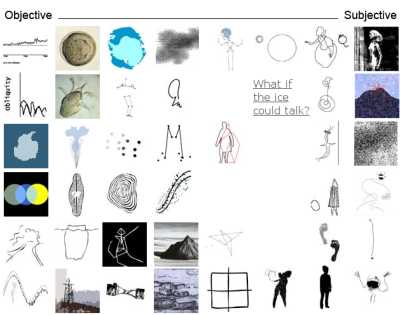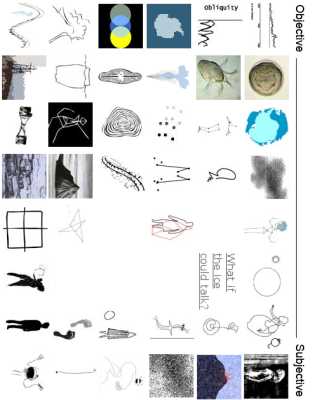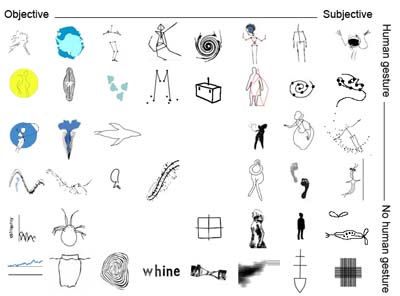This is another arrangement of icons for linking to the animated Encounters.
I will not develop this on-line at the moment however, as I am busy writing about it. Also, I expect my ideas will change. But doing this now has helped me to think through what these animations mean.
The original interface had grown as I made the animations, so it’s arrangement is more or less chronological.
This new way of looking at them suggests another, more interesting, view.
Turned on its side, the objective views of Antarctica – what we see – lie above. what has been imagined and felt about that reality lies below.
This suggests developing an even more interesting interface to suggest the Antarctic environment itself. I have been referring to Antarctica in my thesis as a ‘multi-layered, animated environment’. This interface could suggest that reality.
A graph, made from sounds reflected through the Antarctic ice sheet, immediately suggests itself as a starting point for building this.
Interactive buttons could be made using new icons to identify each animation. (The original images were always temporary place holders.)
This idea reminds me of a drawing I began last year, but could not complete at the time. I had drawn layers and layers of lines but was not clear then what they could contain. They can include these symbols.
I thought of the idea of a taxon of animations while trying to write about Encounters, asking myself, what do the animations mean as a collection? My supervisor, Simon, had suggested a taxon about a year ago. At that stage, however, I had not made enough animations to categorise.
Now I was ready for some kind as a structure within to make sense of the work I had been doing.
Being so close to each frame of each animation for so long, it has taken this long to distance myself from the process.
…
I showed this arrangement to my scientific friend Ken. He said it lent itself to expressing two other polar opposite values, if I could identify them.
This reminded me that as I was arranging the icons, I intuitively placed some higher or lower than others along the unmarked axis.
For example, I placed the icon for ‘Estranged’ on the bottom right hand corner of the grid because this animation represents the most extreme subjective insight, expressed through human gesture.
There was clearly some assessment process at work as I arranged the . But I realised I would need to write about this process to find words to describe it.
He then suggested that if I could not identify other polar opposites, I could consider arranging the icons in groups.
I had also unconsciously been doing this already. For example, I arranged animations that featured voices of scientists close together.
Now I could see groups that could work to identify voices of artists, scientists, and expeditioners.
These groupings could be expressed as a Ven diagram. Circles could overlap to show animations that share the same characteristics.
Polar opposites to consider:Animations that include human gesture and those that do not.
Bodies – No bodies, or Human gesture – no human gesture.
Perhaps there are better words to use. But this seems like a useful starting point. Such a taxon would be a framework within which to assess the animations. Which animations worked best to connect us with changes happening in Antarctica, and with the changes that happen within some of the people who work there?
I will assess individual animations with different taxon. I will analyse their use of space, time and energy in language adapted from Laban and Exiner. From this I will identify possible meanings that can be read from them. I will identify and explain their visual gestural metaphors.
I will compare animations for their use of time, space and energy. I will look for recurring symbols and gestures.
Considering the challenge of explaining art within an academic written thesis, and who will be reading what I write, these lines from poet Billy Collins spring to mind (Read ‘art’ from ‘poem’):
I want them to water-ski across the surface of the poem waving at the author’s name on the shore.
But all they want to do is tie the poem to a chair with rope and torture a confession out of it.
They begin beating it with a hose to find out what it really means.
Billy Collins, 2001, Sailing Alone Around the Room, p. 16
…
Later…
The Taxon:



